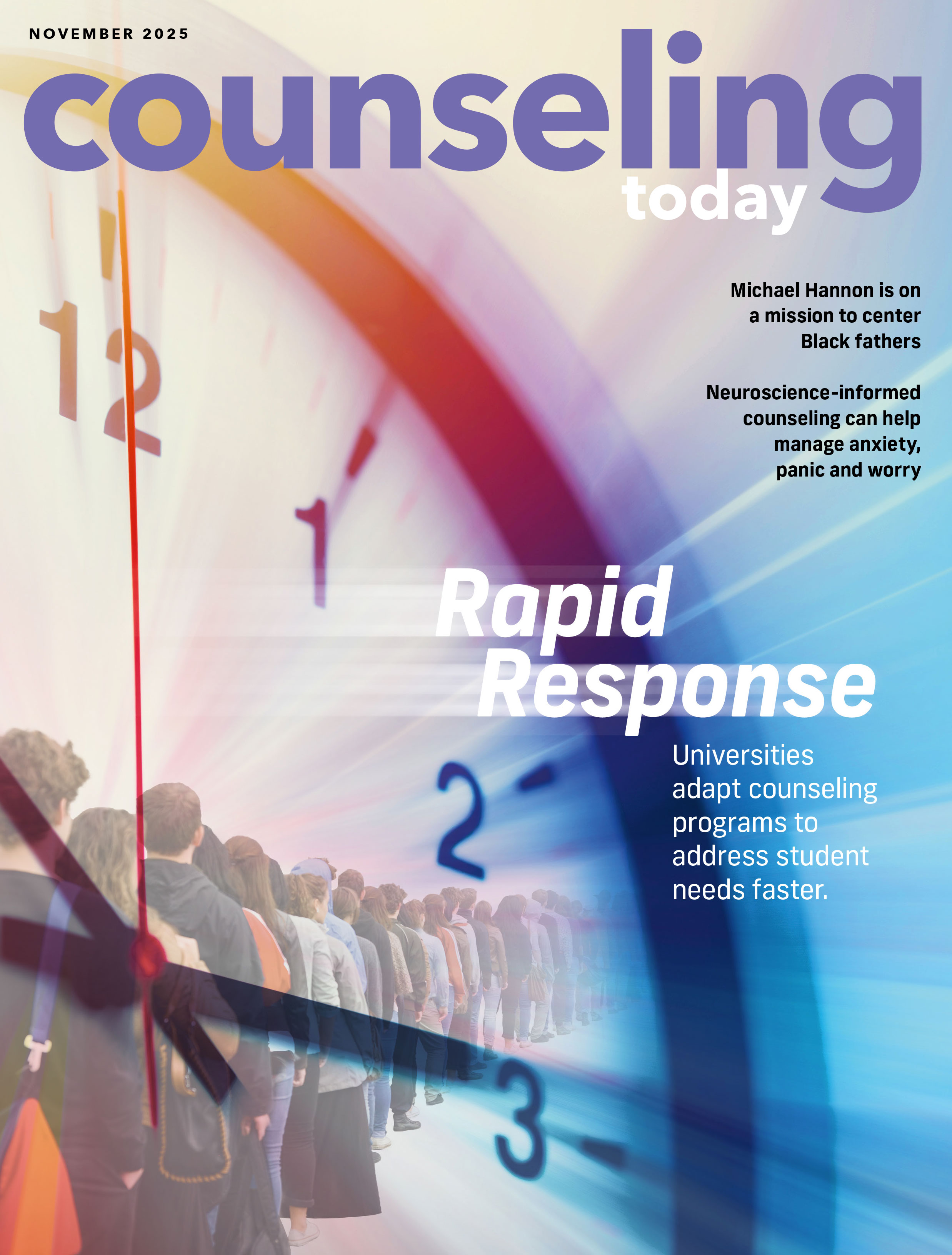Remembering Martin Buber and the I–Thou in counseling
By Matthew Martin and Eric W. Cowan
May 2019

Counseling research designed to measure therapeutic efficacy has increasingly focused on empirically validated methods and interventions. On the other hand, counselors have long understood the therapeutic relationship to be the most powerful meta-intervention for fostering client change and transformation. Carl Rogers’ No. 1 rule — that the counselor and client must be in psychological contact — is the precondition for all therapeutic movement. As counselors, we must “be someone with” rather than “do something to” the client.
However, the interpersonal process that occurs between counselor and client is difficult to quantify because it possesses intangible qualities that slip through the fingers of measurement and scientific scrutiny. The relationship between counselor and client seems to transcend any particular intervention strategy. The maxim “it is the relationship itself that heals” is an organizing principle to which most counselors subscribe and yet still sometimes forget. In the search for empirically validated methods, are we in danger of losing touch with what matters most in counseling?
Another consideration is the cultural shift that has altered how people communicate, with interpersonal contact becoming increasingly digitized, objectified and packaged in virtual platforms. Will the next generation of counselors still give primacy to the sense of “presence” in the therapeutic relationship that is the heart of counseling? From our perspective, it seems that a counselor’s enhanced capacity for meaningful interpersonal contact is more important than ever.
Philosopher Martin Buber detailed the qualities that characterize a real “encounter,” or I–Thou meeting, between two people. His ideas remain as relevant today as when they helped to shape the humanistic movement in psychology and counseling.
The I-Thou encounter
According to Buber, an interpersonal encounter contains wonderful potential that far exceeds two separate people in conversation. This potential becomes apparent when two people actively and authentically engage each other in the here and now and truly “show up” to one another. In this encounter, a new relational dimension that Buber termed “the between” becomes manifest. When this between dimension exists, the relationship becomes greater than the individual contributions of those involved. This type of meeting is what Buber described as an I–Thou relationship.
The I–Thou relationship is characterized by mutuality, directness, presentness, intensity and ineffability. Buber described the between as a bold leap into the experience of the other while simultaneously being transparent, present and accessible. He used the term “inclusion” to describe this heightened form of empathy. It is a far cry from the now-familiar scene of a group of friends sitting around a table at a restaurant, all gazing into their smartphones.
Buber saw the meeting between I and Thou as the most important aspect of human experience because it is in relationship that we become fully human. When one meets another as Thou, the uniqueness and separateness of the other is acknowledged without obscuring the relatedness or common humanness that is shared. Buber contrasted this I–Thou relationship with an I–It relationship, in which the other person is experienced as an object to be influenced or used — a means to an end. Regrettably, the I–It relationship requires little explanation for anyone living in a cultural frame of absent-mindedness and technological materialism.
The world of I–It can be coherent and ordered — even efficient — but it lacks the essential elements of human connection and wholeness that characterize the I–Thou encounter. The I–It attitude is increasingly depersonalizing and alienating as it becomes structuralized in human institutions. When an extreme I–It attitude becomes embedded in cultural patterns and human interactions, the result is greater objectification of others, exploitation of people and resources, and forms of prejudice that obscure the common humanity that unites us.
Although Buber saw the I–It as an essential pole of human existence, he thought humanity was losing its ability to orient toward the Thou. He emphasized the important balance required between the two poles if humanity was to survive the dangers inherent in the possibility of mutual destruction.
Counselors view the client–counselor relationship as the foundation of all therapeutic growth because it is fundamentally affirming of human connection, validation and participation. In our own small sphere of influence, we are a force for promoting a more compassionate and humanized world. Counselors should keep this in mind even as we strive toward greater technical organization and efficiency within a mental health “service delivery system” that is not entirely compatible with our broader aims.
To exist is to be in relation
Buber rightly understood that human development occurs in a relational context. Human beings are highly social creatures who need love and care from others to survive through infancy and beyond. An absence of these relational needs almost always leads to psychological injury.
Buber called this deep participation with, and acceptance of, another’s essential being “confirmation.” He believed that one’s innate capacity to confirm others, and to be confirmed in one’s own uniqueness by others, is the source of our humanity. The innate subjectivity that unfolds within every human being can begin to be actualized only when it is accurately mirrored in the eyes of another. Confirmation is at the heart of the I–Thou meeting, of human flourishing and of counseling.
Confirmation is similar to the concept of not imposing “conditions of worth” in the relationship. However, confirmation goes a step further by acknowledging the person’s potentialities — what one may become. For example, a child experiences the tension between growth and fear along each step of the developmental path. The parent can either accept the child’s reluctance in the moment or encourage the child to take the leap. At all ages, human thriving is found in these continual moments of confirmation of potentiality from person to person. As a client struggles with making the “growth choice” or the “fear choice,” the counselor invites the client to greater participation, yet expects to bump into the old fears that make such participation fraught for the client.
Unfortunately, we aren’t always as mindful and present as we’d like to be with others, and we ourselves have not been affirmed in the eyes of others as often as we would like. Even the best of us can fall into an I–It orientation with the world, failing to see the other person at all. Buber believed that these “missed meetings” were the ultimate failure of human relationships and resulted in us losing a part of ourselves.
We all desire to be confirmed in our uniqueness, but when we realize that confirmation is not going to happen, we seem to sacrifice true confirmation for mere approval in hopes of preserving our attachment to others. We cultivate the ability to “seem” a certain way to others to elicit approval, but such approval does nothing to nourish our “being.” A person would rather be confirmed in that which he or she is not than chance the possibility of not being accepted at all.
Unfortunately, this “seeming” mask tends to get stuck, and as one hides one’s being in fear, the possibility of an I–Thou relationship is lost. As Buber cautioned, “To yield to seeming is man’s essential cowardice, to resist it is his essential courage.” When the I of the I–Thou relationship is sacrificed for the It orientation of abstracted relation, authentic human growth and connection are lost, and the I begins to wither away.
Healing through meeting
How can we as counselors foster and model I–Thou relationships with our clients and help them avoid the temptation of “seeming” like someone they are not? Buber thought the answer could be found in a process of active imagination that he termed “inclusion.” In this process, the barriers and constrictions that prevent one from being fully present to an I–Thou encounter indicate where the work is to be done. In what ways must the client stay hidden from others and protect his or her own inner thoughts, feelings and fantasies?
In inclusion, one imagines what another person is feeling, thinking and experiencing while standing in relation to them as a Thou. Rogers’ concept of empathy and Buber’s concept of inclusion are similar (in fact, the two of them debated about it). However, inclusion places greater emphasis on the unique subjectivity of the person attempting to understand the other.
The attempt at understanding the subjective inner world of the person is not a one-way street because the counselor must account for his or her own influence upon the client as both participants come into psychological contact. The I–Thou is a relational event that is co-created; it does not fully reside in one participant or the other. The counselor’s ability to mine the riches of the present encounter and wonder “what is happening between us in the immediate moment” expresses Buber’s notion of inclusion.
We as counselors have the ability to confirm our clients through the process of inclusion, providing them with a relationship that can heal the wounds of their past missed meetings. We must stand in relation to our clients as an I to a Thou to successfully inspire them to move from a “seeming” stance to one of greater authentic participation and “being.”
Although empirical methods and interventions are critical in guiding our understanding of best practices, we must not forget that the single most predictive variable in whether counseling is effective is the client’s experience of the counseling relationship itself. Clients deserve to be seen as a Thou. As Buber once said, “In spite of all similarities, every living situation has, like a newborn child, a new face that has never been before and will never come again. It demands of you a reaction that cannot be prepared beforehand. It demands nothing of what is past. It demands presence, responsibility; it demands you.”
Every moment is an opportunity for “healing through meeting."
****Matthew Martin is a graduate of James Madison University’s clinical mental health counseling master’s program. He is currently completing his residency in counseling at the university’s counseling center. Contact him at matthewmartin.rva@gmail.com.
Eric W. Cowan is a professor in the Department of Counseling and Graduate Psychology at James Madison University. He is the author of Ariadne’s Thread: Case Studies in the Therapeutic Relationship. Contact him at cowanwe@jmu.edu.
Letters to the editor: ct@counseling.org
Counseling Today reviews unsolicited articles written by American Counseling Association members. To access writing guidelines and tips for having an article accepted for publication, go to ct.counseling.org/feedback.
**** Opinions expressed and statements made in articles appearing on CT Online should not be assumed to represent the opinions of the editors or policies of the American Counseling Association.

